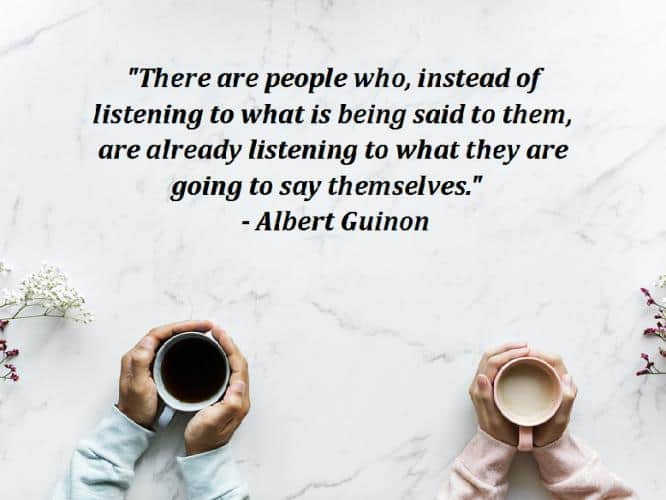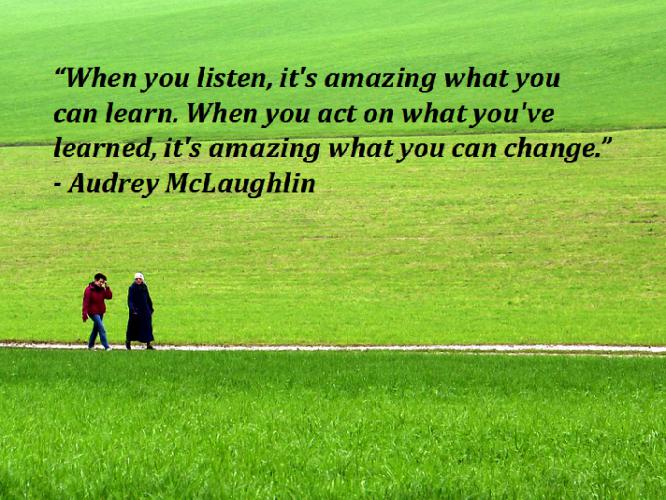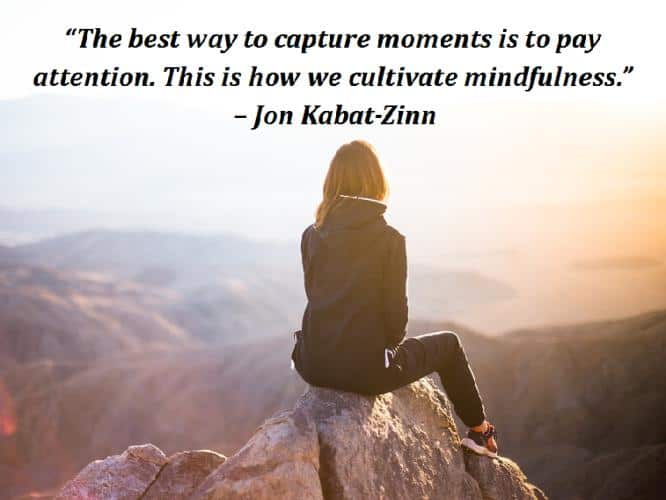Mindful listening is a practice to pay attention on purpose, be in the moment in a non-judgmental way. Listening mindfully gives us the opportunity to have an open mind to the speaker’s ideas. It encourages to be aware of the present moment and let go of any distractions be it physical or emotional. Do you know an average human mind retains only 25% of what the speaker says just a minute ago? Therefore, you tend to listen to others half-heartedly and experience an instant emotional reaction to it.
“The biggest communication problem is that we do not listen to understand. We listen to reply.”
The idea is to understand the difference between ‘hearing’ and ‘listening”. Hearing is “the act of receiving sound or information by the ear.” However, listening is “the act of paying attention to sound, hearing something with thoughtful attention. Or paying attention to someone or something in order to hear and understand what is being said, sung, or played.”
How to Build Awareness on Listening Mindfully Everyday
Why – Mindful Listening
Mindful listening silences your distractions – both internal or external in nature to hear attentively. Your internal distractions could be psychological or emotional. However, you get distracted externally due to visual, auditory or physical noises. By practising Mindful listening you give 100 % attention to the speaker. It is crucial to develop an attitude of listening by eliminating any kind of distraction. Remember, resisting distractions and listening actively can make you a more effective listener.
Mindful Listening begins when you understand the true meaning of Active Listening. “Active listening is a technique that is used in counselling, training and solving disputes or conflicts. It requires that the listener fully concentrates, understands, responds and then remembers what is being said.”

Why do we Succumb to – Mindless Listening
Psychiatrist and Founder of Wellness Orbit, Helena Lass says that poor listening is due to the lack of skills one has in directing awareness purposefully. She calls this state “The Monkey-Mind Syndrome”. A state when the mind is unsettled, restless, confused and distracted. Only 10% of people actually mindfully listen and remember 50% of what is said immediately. Moreover, as per studies 45% of the time you get distracted by self-interrupting unintentionally and start listening mindlessly to thoughts and emotional reactions.
Mindless listening is when, while interacting, listening or watching someone live, or an audio or video – instead of paying attention you start getting distracted.
Moreover, you act on pseudo listening (fake listening) by nodding your head when you do not want to look disrespectful. During such times, you either interrupt, dominate the conversation or start judging even while the speaker is still speaking. Often you do not even wait for the others to stop before you rattle off in between by speaking out your opinion on the subject. By doing this you miss out on the full meaning behind what the other/s are saying. You succumb to mindless listening as you judge, criticize and contradict people when their opinions don’t match yours.
In his book “Get Out of Your Own Head: Mindful Listening for Project Managers,” Charlie Scott emphasizes on how psychological barriers could inhibit communication. Reasons being – feeling fearful, jealous, defensive, assuming incorrectly, past prejudices or unsolicited advice. Therefore, if you start practising active listening you automatically overcome the psychological barriers. It results in: reduced conflicts and misunderstandings, improved personal relationships, deepens cooperation and fosters understanding.
The big question is – How can we learn the Art of Mindful Listening?

Active Listening Creates Awareness
Listening is affected by our past experiences and future expectations. Mindful listening creates awareness on how we listen and to what we listen so attentively.
Active listening uses all 5 senses to listen verbally, non-verbally and relationally. You listen relationally when you read between the lines based on how well you know the relationship and the conversations with your partner from past experiences. This experience leads to a higher quality of conversation with your partner and with others. Active listening builds relationships and trust with others.
Attentive and active listening can also help solve relationship problems of any kind and expand your understanding. For example, active listening in the workplace results in higher productivity and more efficiency. A competent manager is successful in keeping a team together when he spends 60% of his/her day listening to his colleagues.
Mostly, people let emotional and mental reactions be the drivers in their lives, however, the magic of awareness can open up pathways of profound and mindful listening. The moment one is aware of its reactions and feelings and is not overpowered by them, they can keep their mind active and alive. Self- talk is healthy and beneficial only when you are alone in your space internally and externally. However, the same self-talk during a conversation with someone else depletes the brain from being aware. It does not let external knowledge enter into the mind.
Communications Instructor, Denise Besson-Silvia, describes the differences between “Mindless vs “Mindful Listening” and how it affects relationships.

How to Build Awareness on Listening Mindfully Everyday to Build Awareness
You practice listening mindfully by paying attention, being present at the moment, become aware of your thoughts and surroundings without judging.
1. Internal and External
Distractions could be of two kinds – Internal or External.
Internal distractions are your psychological and emotional noise. It makes you react physically by responding to the environment. For example – feeling hungry, physically uncomfortable or upset are – external distractions. You may be doing an inner monologue or listening to that “little voice in your head” by thinking non-related thoughts.
External distractions are mostly in the form of noise in the physical environment. Thus, they are visual or auditory in nature and easily identifiable. Loud voices or noise inhibit effective listening as there are distracting external images. Imagine trying to have a deep conversation when there is a video of a child crying loudly in the background. Sounds difficult- right?
While practising mindful listening the key is to deal with distractions. Firstly, tidy up your living or workspace/s of clutter or relocate to a quieter place. Secondly, turn off mobile devices and apps and close the unwanted windows on the computer. Thirdly, finish work in hand before you start listening to something or pause the task at hand and mindfully focus. Lastly, avoid distractions by addressing your questions after the talk/presentation, not during.

2. Pay Attention
Mindful listening involves exercising empathy and suspend judgment. The following methods will help you develop listening skills by paying more attention. Read to know-how:
i) Be at the same level as the speaker
Make eye contact and be on the same level as the speaker physically. Show you are listening through your body language and convey that you are interested in what the speaker is saying.
When you listen mindfully you become aware of the nature of the conversation that is coming and how the speaker feels around you.
ii) Encourage the speaker to tell you more
Respond with by nodding and smiling, and asking them to tell you more. As a result, listening builds trust and this will show them that you are listening mindfully with interest and attention.
iii) Cultivate Empathy
Understanding the speaker’s situation and point of view will build awareness. This will further acknowledge the speaker’s perspective or opinion. Listen with empathy and mindfulness.
Psychologist Marshall B. Rosenberg introduces mindful listening as receiving empathy in his book – Nonviolent Communication. He says that mindful listening requires us to empty our minds and listen with our whole being. To hear what others feel, observe, need and request through their conversation. It is not easy to maintain our presence of mind and be aware but listening mindfully, we give others the space to share without interrupting, or correcting them.
iv) Become aware of your own cues
Cues here refer to your thoughts, feelings and physical reactions when you are anxious or angry on an uncomfortable topic. Mindful listening can help you to be more aware of your cues, and allow you to choose not to let them block communication. Notice how you feel about a certain topic. Does it make you feel happy and relaxed or does it create tense thoughts in your mind? Thus, try to be mindful at that moment and monitor your feelings.

3. Re-Schedule Your Conversation
To be able to practice mindful listening or have a mindful conversation, you need to be in the right frame of mind. If you feel you cannot give the other person the full attention, then choose another time to have that conversation. To ask this of someone is perfectly fine. Do not feel guilty or sad about it. This does not mean you have betrayed someone from not listening to them.
Tell your family or friend the reason why you can’t have the conversation and ask for another time or day. This will help them realize that you value what they are going to say. For example, if you are feeling tired, or angry and your friend calls up to talk, excuse yourself politely and tell them you will speak to them soon.
4. Meditate
Give yourself time to clear your mind before you meet someone to have a conversation with. Practice a few mindfulness meditation exercises such as deep breathing or chanting meditation. This will increase your focus and you will also be more aware of the conversation. Even 5 to 10 minutes a day can help.
BOTTOM LINE
Mindful listening only requires focus and attention in the present moment. Be an active listener and not a passive one. Value what the other person is saying. Also, mindful listening is a way of listening without judgment, criticism or interruption, and being aware of your internal thoughts and reactions.
To be able to practice mindful listening, most importantly de-clutter your mind. This is achievable through mindful meditation or self-talk.
Thus, listen mindfully and attentively to build relationships and keep trust among them.
Read More:
What is Mindfulness? Benefits of Mindfulness
Slow Down – take Notice – Practise Mindfulness
Easy Steps to Start Meditation for Beginners
8 Ways to Attract Good and Positive Energy on your Life daily
12 Fun Ways of Teaching Mindfulness Games to Kids
References:
https://www.hrmagazine.co.uk/article-details/effective-listening-by-using-awareness
https://www.developgoodhabits.com/mindful-listening/
https://kimberlymccloskey.wordpress.com/2009/11/13/listening-awareness/
https://www.tut.com/article/details/102-the-art-of-listening-with-awareness/?articleId=102#popup
https://www.mindtools.com/pages/article/mindful-listening.htm
https://chopra.com/articles/art-and-practice-mindful-listening
https://www.psychologytoday.com/us/blog/conscious-communication/201703/mindful-listening
https://www.verywellmind.com/what-is-active-listening-3024343








